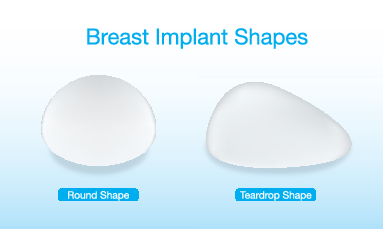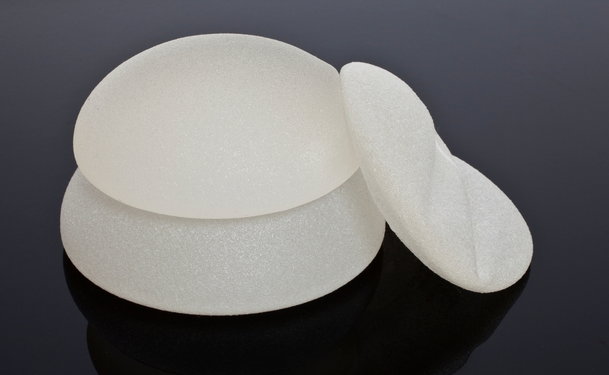With so many options, choosing the right breast implant can be an overwhelming part of the breast augmentation surgery process for patients. Besides deciding on implant size, which alone can be a difficult decision, there are other implant variables like material (silicone or saline), shape, texture, and profile.
Knowing more about breast implant types will help you walk into your consultation with a clearer picture of how you want your breast augmentation to look and feel.
Breast implant shapes: round vs. teardrop
There are two options in breast implant shapes: round or teardrop (anatomical) implants.

Round implants
Round implants are the most commonly used, coming in saline or silicone, smooth or textured, and various projection profiles. They are softer, have an extensive selection, and are the least expensive. When placed on a flat surface, a round implant has a flat bottom and a domed-shape top. In the body, the round shape settles into a form similar to a teardrop implant, but not exactly. Because round implants are, well, round, they maintain the same shape all over. This means more upper pole fullness and should the implants rotate, they will appear no different to the eye.
While round implants have a reputation for looking augmented or fake—and it's possible depending on your anatomy, implant choice, and implant placement (e.g., over or under the muscle)—you can achieve a natural look with a skilled breast implant surgeon.
Teardrop (anatomical) implants
Teardrop (anatomical) implants mimic the natural breast, having a sloping top and fuller bottom. Within them are a highly cohesive silicone gel that makes them more durable and less susceptible to rupture. The thick gel also helps these implants maintain their shape longer than round silicone.
Though customizable by width, height, and projection, they are limited to textured “gummy bear” silicone, and because they contain a firmer, less flexible silicone gel, surgeons must make larger breast incisions to place them. This ultimately leads to more prominent breast augmentation scars.
Teardrop implants make an excellent choice for those who have thin tissue coverage but still desire natural-looking (though not natural-feeling) implants, or for “reconstructive patients where creating a shape is needed as they have no remaining breast tissue,” said Dr. Cameron Craven of Austin-based Westlake Dermatology & Cosmetic Surgery.
“In a cosmetic augmentation,” he added, “the patient already has a breast shape and simply seeks to enlarge and enhance it. In this case, the softer nature of round implants, lower cost, and the smaller incision make it preferable to most cosmetic augmentation patients.”
Breast implant textures: Textured vs. smooth
Breast implants may be textured or smooth.
Textured implants
A textured coating is on all teardrop (anatomical) implants and is an option for round breast implants with saline or silicone. The rough, textured cover is designed to reduce the rate of capsular contracture, the idea being that the surface of the implant adheres to the breast tissue and minimizes contractile forces that lead to hardening.
But it's textured shell also means a thicker shell, which results in the implants feeling slightly firmer to the touch. They also have a unique complication called traction rippling where, when the overlying tissue adheres to the implant shell, it pulls the tissue into a wrinkle or ripple, sometimes giving the implants more of a stuck on feel.
Smooth implants
Smooth implant shells have a thinner, sleeker shell that makes them effortlessly glide in the breast pocket and feel softer. The mobility causes less drag and less visible rippling than you'd get with textured implants because they don't adhere to the breast tissue, instead they move freely in the breast pocket.
This movement also adds to their naturalness as the implants move in accordance with the breast tissue, much like the breasts would normally if there were no implants at all. However, the free shifting can increase your risk of implant malposition and bottoming out, especially if the implants are over the muscle.
Breast implant fill types: saline vs. silicone
There are different breast implant types: saline, silicone, and a blend of the two.
Saline implants
Saline implants consist of an elastic silicone shell and saline (salt water) fill. The shells come to your surgeon empty. They are slid through a small incision and are filled only after being placed in the breast pocket. For this, the incision is considerably smaller than you would receive with a form-stable silicone implant and fill limitations are not only greater but can be adjusted up and down during breast augmentation to come closer to your desired goal.
This implant type comes in smooth or textured and ranges in thickness, shape, and profile. Thinner shells will feel softer but still firmer than silicone implants due to the shell needing to be thicker to contain the solution inside. If the solution leaks out, it is absorbed and safely eliminated by the body.
Saline implants are good for those looking for a firmer implant and upper pole projection, or for those with lots of breast tissue and fat to conceal the implant.
Silicone implants
Silicone implants are currently broken down into two categories: cohesive gel and form-stable gel (gummy bear). Both have soft, but durable silicone shells with a cohesive silicone gel inside. This makes for the breasts feeling more natural once they are placed.
Cohesive silicone gel implants
Cohesive silicone gel implants come pre-filled and are the softest and most natural-feeling option. Each implant brand has their options for the level of cohesion and softness for their silicone gel. They are available in a round implant with a smooth or textured shell and up to 800cc in size.
Gummy bear breast implants
Gummy bear implants are a more form-stable silicone gel implant. While still soft and natural-feeling, they do feel firmer than the cohesive silicone gel. Sientra offers a form-stable gel implant in a round implant shape, but all brands that offer an anatomical implant use form-stable gel. The structured silicone gel does require a larger incision, however.
Both cohesive and gummy bear breast implants are great for thin women with little body fat and breast tissue. If either type ruptures, the breasts will often look and feel the same because the gel slowly bleeds out into the breast capsule or breast tissue, though it may even transport to the other areas like the lymph nodes. When this happens, patients can develop late-stage capsular contracture or lymphadenopathy.
Silicone-saline blends
Ideal implants are the latest addition to the implant market and give women the best of both worlds with its silicone-saline blend. They are a saline-filled implant that attempts to bridge the gap in softness between traditional saline and silicone gel.
This implant uses an inner shell filled with saline to give the implant a shaped structure similar to silicone. There is an outer saline shell that holds additional saline filler. Between the two shells are three baffle shells that are designed to eliminate any sloshing movement of the saline filler.
Since these implants are still relatively new—approved by the FDA in 2014—and have not undergone rigorous testing, many plastic surgeons don’t use them due to concerns over failure and the potential for breast deformity.
Breast implant profiles: low, medium, high
Breast implant profile refers to how far a breast implant projects forward from the chest when standing. Implant profiles come in low, medium and high and which one you choose will be based on your goals and preoperative measurements. Your goals pair with a particular style or profile of the implant, and your measurements of existing breast tissue and soft tissue dimensions further determine if the goals are realistic and maintainable.
“Commonly, however, women with wide chest walls and wide breasts are best served with low or moderate profile implants to avoid unnaturally large implant volumes,” said Dr. Craven. “Narrower breasted women can really choose whichever profile fits their desired outcome, and most frequently they opt for moderate or high profile implants.”
Want to know more about breast implant types?
When you have questions about breast implant types, who better to hear from than an extensive network of board-certified plastic surgeons? Think of some questions, any questions, and shoot them over to our "Ask a Surgeon" Q&A forum. Plastic surgeons from across the country will receive them and provide answers that fill in the gaps.



